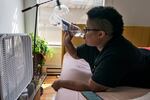As parts of Oregon endure their first serious winter storms of the season, a new study is looking to the warmer months ahead.

FILE: Katherine Morgan drinks water in front of a box fan while trying to stay cool in her downtown apartment without air conditioning on Aug. 12, 2021, in Portland.
Nathan Howard / AP
The Oregon Department of Energy’s Cooling Needs Study, published this month, found many of Oregon’s most vulnerable residents do not have sufficient cooling equipment in their homes to stay cool during summer heat waves.
ODOE staff developed the study to understand how to help Oregon’s most vulnerable populations stay cool during extreme heat events. The agency surveyed people living in manufactured dwellings, mobile homes, recreational vehicles, publicly-supported housing and employer-provided agricultural workforce housing from across the state.
According to the agency, these housing types are some of the most vulnerable to heat because the homes lack proper insulation, adequate ventilation and safe electrical wiring, or they are located in areas with few trees to provide shade during the day.
The study found that 58% of those surveyed lack sufficient cooling devices, such as air conditioners or heat pumps.
ODOE Facilities Engineer Stephanie Kruse said the results show a significant portion of the state’s population is not prepared to keep cool during a heatwave. It would cost hundreds of millions of dollars to provide a baseline level of cooling in these homes, she said.
“That might include temporary cooling equipment or cooling equipment that only serves one room in a house,” she said. “That came to a total of $604 million.”
To install permanent equipment like ductless heat pumps or central air conditioning throughout a home, the total estimate came to a little over $1 billion.
The study comes after nearly 100 Oregonians died of heat-related illnesses during a 2021 heat dome event that saw temperatures soar to 116 degrees in Portland. Many residents who perished from the heat lived in the kinds of homes the agency surveyed. Some were found alone in their homes with no cooling devices.
As Oregon summers are getting hotter due to climate change, the state department’s study underscores the need to invest in life-saving cooling devices, something that hasn’t always been a priority due to the Northwest’s history of milder weather.
Among those surveyed, 84% said they want to improve their cooling systems.
Kruse said some residents made their own makeshift cooling devices during recent heatwaves, like swamp coolers, or had one cooling device in a shared space. Others lacked proper insulation or had poorly installed AC window units.
There were a variety of reasons why these homes lacked proper cooling equipment, Kruse said. A major challenge residents faced was the costs of cooling units, she said, which is a reason why the estimated number to provide permanent cooling equipment was more than $1 billion.
One existing option residents can tap is heat pump programs, which the state has supported since the 2021 heat dome. These offer low-cost or free heat pumps to people who need them.
“We always recommend people reach out to their local utility to find out whether there’s any options available, if they think that they are low-income qualified,” she said. “Those programs provide comprehensive weatherization and heating and cooling equipment assistance.”
The state energy department is also hoping to receive federal funds to further offset costs for vulnerable residents. Although those funds would be significant, Kruse said it is still not going to meet the full need of the state.
Last year, lawmakers passed the Climate Resilience Package, a compilation of more than a dozen bills with a focus on community resiliency, adaptation and reducing the state’s greenhouse gas emissions in the building sector. One of the bills created a goal of installing 500,000 heat pumps across the state by 2030. Kruse said meeting that goal would definitely help people feeling the effects of climate change.
Kruse said the study will help lawmakers and others addressing cooling shortages to get resources to “where the needs are most pressing.”
The agency also developed a heat vulnerability index that shows which areas and populations are most at risk during extreme heat.
The counties with the highest heat vulnerability are Morrow, Multnomah, Malheur, Marion, Umatilla and Wheeler. Residents in these counties have an increase in exposure and limited capacity to adapt to the heat, according to the energy department.
